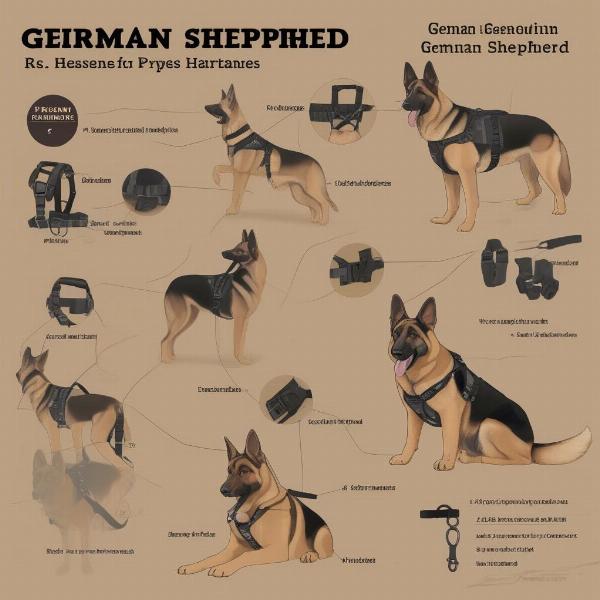A German Shepherd Dog harness is more than just a stylish accessory; it’s a vital tool for training, walking, and overall safety. Finding the right one for your energetic and intelligent German Shepherd can significantly improve your bond and make daily activities more enjoyable for both of you. Whether you’re dealing with a puppy’s boundless energy, an adult’s strength, or a senior’s delicate needs, this guide will help you navigate the world of German Shepherd dog harnesses, ensuring a perfect fit for your furry companion.
Harness Types for Your German Shepherd
Selecting the correct German Shepherd dog harness depends on several factors, including your dog’s age, activity level, and specific training needs. Let’s delve into the most popular types and their suitability for German Shepherds:
-
Back-Clip Harnesses: These harnesses feature a clip on the back, which is ideal for relaxed walks with well-trained dogs. They discourage pulling by gently steering the dog from the back.
-
Front-Clip Harnesses: The front clip attachment point discourages pulling by redirecting the dog’s forward momentum. This type is particularly beneficial for German Shepherds prone to pulling or those undergoing leash training.
-
Dual-Clip Harnesses: Offering both front and back clip options, these harnesses provide versatility. Use the front clip for training and the back clip for casual walks.
-
Tactical Harnesses: Built for durability and control, tactical harnesses are suitable for active German Shepherds participating in activities like hiking, running, or protection work. They often feature multiple attachment points and handles.
-
No-Pull Harnesses: These specialized harnesses are designed to minimize pulling by applying gentle pressure to discourage the behavior.
 German Shepherd Dog Harness Types
German Shepherd Dog Harness Types
Finding the Right Fit for Your German Shepherd
Ensuring a proper fit is crucial for your dog’s comfort and safety. A well-fitted harness should be snug but not restrictive, allowing for a full range of motion.
-
Measure Accurately: Use a soft measuring tape to determine your German Shepherd’s girth (around the chest, behind the front legs) and neck circumference. Refer to the manufacturer’s size chart for accurate sizing.
-
Adjustability is Key: Look for harnesses with adjustable straps to fine-tune the fit as your dog grows or changes weight.
-
The Two-Finger Rule: You should be able to comfortably fit two fingers between the harness and your dog’s body.
Material and Durability
German Shepherds are known for their strength and active nature, so choosing a durable harness made from high-quality materials is essential.
-
Nylon: A popular choice due to its durability, water resistance, and easy cleaning.
-
Leather: Offers a classic look and excellent durability, but requires more maintenance.
-
Neoprene: A comfortable and padded option, often used in no-pull harnesses.
Consider the climate and your dog’s activity level when selecting the material.
Harness Training for Your German Shepherd
Introducing a harness to your German Shepherd should be a positive experience. Start by associating the harness with positive reinforcement, such as treats and praise.
-
Gradual Introduction: Let your dog sniff and investigate the harness before putting it on.
-
Positive Reinforcement: Reward your dog for wearing the harness, gradually increasing the duration.
-
Leash Training: Once your dog is comfortable wearing the harness, attach the leash and practice walking in a controlled environment.
Conclusion
Choosing the right German Shepherd dog harness is a crucial step in ensuring your dog’s safety, comfort, and overall well-being. By considering factors like harness type, fit, material, and training techniques, you can find the perfect harness to enhance your bond and make daily activities more enjoyable for both of you.
FAQ
- What type of harness is best for a German Shepherd puppy? A front-clip or dual-clip harness is recommended for puppies, as it helps with leash training and prevents pulling.
- How do I know if my German Shepherd’s harness fits correctly? You should be able to fit two fingers between the harness and your dog’s body.
- What material is best for a German Shepherd harness? Durable nylon or leather are good choices, depending on your dog’s activity level and the climate.
- How do I introduce a harness to my German Shepherd? Start slowly with positive reinforcement, gradually increasing the duration of wear.
- Can I use a harness for training my German Shepherd? Yes, harnesses are excellent tools for training, especially front-clip and no-pull harnesses.
- Are tactical harnesses suitable for everyday use? While durable, tactical harnesses may be too bulky for everyday walks. They are best suited for specific activities like hiking or protection work.
- How often should I clean my German Shepherd’s harness? Clean the harness regularly, especially if it gets wet or dirty, following the manufacturer’s instructions.
You Might Also Be Interested In:
About ILM Dog: ILM Dog is your trusted international resource for comprehensive dog care information, covering everything from breed selection and puppy care to senior dog health and training tips. We offer expert advice on nutrition, grooming, exercise, and product recommendations to ensure your canine companion thrives. Whether you’re a new dog owner or a seasoned enthusiast, ILM Dog provides reliable guidance and practical solutions for every stage of your dog’s life. Contact us for personalized support: Email: [email protected], Phone: +44 20-3965-8624.